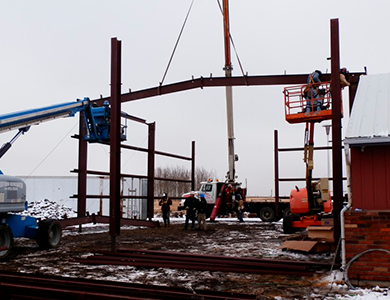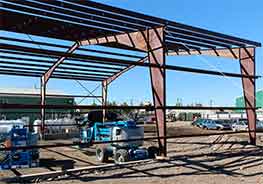Steel buildings have become an integral part of modern architecture and construction, representing innovation, sustainability, and efficiency. Their rising popularity is not a coincidence, but rather a result of numerous advantages over traditional building materials. In this blog, we will explore the reasons behind the growing trend of steel buildings, their applications, and why they are considered the future of construction.

The Advantages of Steel Buildings
- Durability and StrengthSteel is known for its incredible strength and durability. Unlike wood, it does not warp, crack, or rot, and it is resistant to pests such as termites. This makes steel buildings incredibly long-lasting and capable of withstanding extreme weather conditions, including heavy snow, strong winds, and even earthquakes.
- Cost-EffectivenessWhile the initial cost of steel might be higher than some traditional materials, the long-term savings are significant. Steel buildings require less maintenance, and their durability means fewer repairs and replacements over time. Additionally, steel can be prefabricated, reducing labor costs and construction time.
- Design FlexibilitySteel offers unparalleled design flexibility. Architects and builders can create wide-open spaces without the need for interior columns, allowing for more versatile and functional layouts. This flexibility is especially beneficial for industrial and commercial buildings where large, unobstructed spaces are essential.
- SustainabilityIt is 100% recyclable, and many steel buildings are made from recycled materials. Moreover, steel's durability means fewer resources are needed for maintenance and repairs, further reducing its environmental impact.
- Energy EfficiencyModern steel buildings can be designed with energy efficiency in mind. Insulated panels, reflective roofing materials, and energy-efficient windows can be incorporated into steel structures to reduce energy consumption. This not only benefits the environment but also leads to significant cost savings on heating and cooling.
Applications of Steel Buildings
Steel buildings are incredibly versatile and can be used in a variety of applications:
- Commercial BuildingsSteel is an excellent choice for commercial buildings such as offices, retail stores, and shopping centers. Its strength and flexibility allow for large, open spaces that can be easily reconfigured as business needs change.
- Industrial FacilitiesIndustrial buildings, including warehouses, factories, and distribution centers, often require large, unobstructed spaces. Steel's durability and ability to span long distances without support columns make it ideal for these types of structures.
- Agricultural BuildingsSteel buildings are commonly used in agriculture for barns, storage sheds, and livestock facilities. Their resistance to pests and harsh weather conditions makes them a reliable choice for protecting valuable agricultural assets.
- Residential HomesWhile less common, steel is also being used in residential construction. Modern steel homes are not only durable and energy-efficient but also offer unique and contemporary designs that stand out from traditional wooden houses.
- Recreational Facilities Gyms, sports arenas, and community centers benefit from steel construction due to the need for large, open interior spaces. Steel buildings can accommodate high ceilings and wide spans, making them perfect for recreational use.

The Future of Steel Buildings
As the demand for sustainable and efficient construction continues to grow, steel buildings are poised to play a significant role in the future of construction.
- Advanced Prefabrication TechniquesPrefabrication is already a key advantage of steel buildings, but advancements in technology are making it even more efficient. Automated systems and improved design software allow for faster and more precise fabrication, reducing waste and further lowering costs.
- Integration with Smart TechnologiesThe integration of smart technologies into steel buildings is becoming more common. From energy-efficient systems to advanced security features, smart technologies enhance the functionality and sustainability of steel structures.
- Sustainable Building PracticesAs environmental concerns continue to drive changes in the construction industry, steel buildings will benefit from increased emphasis on sustainable practices. This includes the use of recycled materials, energy-efficient designs, and environmentally friendly construction methods.
- Innovative Design SolutionsArchitects and designers are continually finding new ways to utilize steel in innovative and creative ways. This includes unique architectural features, mixed-use developments, and adaptive reuse of existing steel structures.
Conclusion
Steel buildings are considered the future of construction due to their durability, cost-effectiveness, design flexibility, sustainability, and energy efficiency. Whether for commercial, industrial, agricultural, residential, or recreational use, steel offers numerous advantages that make it an ideal choice for modern construction projects. As technology and sustainable practices continue to evolve, steel buildings will remain at the forefront of architectural innovation, shaping the landscapes of our cities and communities for years to come.






